Yize Chen
DeepfakeBench-MM: A Comprehensive Benchmark for Multimodal Deepfake Detection
Oct 26, 2025Abstract:The misuse of advanced generative AI models has resulted in the widespread proliferation of falsified data, particularly forged human-centric audiovisual content, which poses substantial societal risks (e.g., financial fraud and social instability). In response to this growing threat, several works have preliminarily explored countermeasures. However, the lack of sufficient and diverse training data, along with the absence of a standardized benchmark, hinder deeper exploration. To address this challenge, we first build Mega-MMDF, a large-scale, diverse, and high-quality dataset for multimodal deepfake detection. Specifically, we employ 21 forgery pipelines through the combination of 10 audio forgery methods, 12 visual forgery methods, and 6 audio-driven face reenactment methods. Mega-MMDF currently contains 0.1 million real samples and 1.1 million forged samples, making it one of the largest and most diverse multimodal deepfake datasets, with plans for continuous expansion. Building on it, we present DeepfakeBench-MM, the first unified benchmark for multimodal deepfake detection. It establishes standardized protocols across the entire detection pipeline and serves as a versatile platform for evaluating existing methods as well as exploring novel approaches. DeepfakeBench-MM currently supports 5 datasets and 11 multimodal deepfake detectors. Furthermore, our comprehensive evaluations and in-depth analyses uncover several key findings from multiple perspectives (e.g., augmentation, stacked forgery). We believe that DeepfakeBench-MM, together with our large-scale Mega-MMDF, will serve as foundational infrastructures for advancing multimodal deepfake detection.
Multi-Task Vehicle Routing Solver via Mixture of Specialized Experts under State-Decomposable MDP
Oct 24, 2025
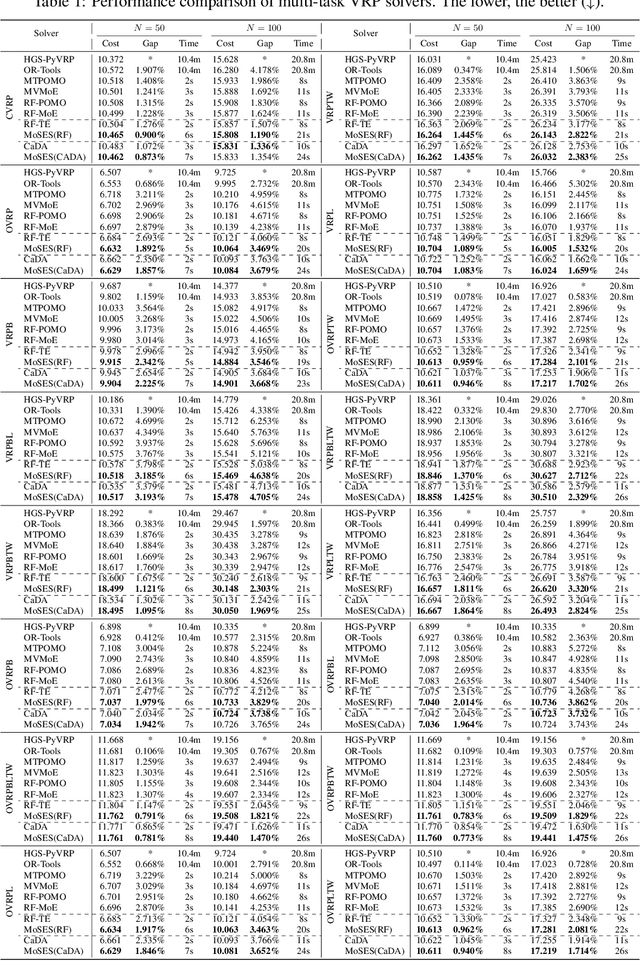


Abstract:Existing neural methods for multi-task vehicle routing problems (VRPs) typically learn unified solvers to handle multiple constraints simultaneously. However, they often underutilize the compositional structure of VRP variants, each derivable from a common set of basis VRP variants. This critical oversight causes unified solvers to miss out the potential benefits of basis solvers, each specialized for a basis VRP variant. To overcome this limitation, we propose a framework that enables unified solvers to perceive the shared-component nature across VRP variants by proactively reusing basis solvers, while mitigating the exponential growth of trained neural solvers. Specifically, we introduce a State-Decomposable MDP (SDMDP) that reformulates VRPs by expressing the state space as the Cartesian product of basis state spaces associated with basis VRP variants. More crucially, this formulation inherently yields the optimal basis policy for each basis VRP variant. Furthermore, a Latent Space-based SDMDP extension is developed by incorporating both the optimal basis policies and a learnable mixture function to enable the policy reuse in the latent space. Under mild assumptions, this extension provably recovers the optimal unified policy of SDMDP through the mixture function that computes the state embedding as a mapping from the basis state embeddings generated by optimal basis policies. For practical implementation, we introduce the Mixture-of-Specialized-Experts Solver (MoSES), which realizes basis policies through specialized Low-Rank Adaptation (LoRA) experts, and implements the mixture function via an adaptive gating mechanism. Extensive experiments conducted across VRP variants showcase the superiority of MoSES over prior methods.
BEAVER: Building Environments with Assessable Variation for Evaluating Multi-Objective Reinforcement Learning
Jul 10, 2025Abstract:Recent years have seen significant advancements in designing reinforcement learning (RL)-based agents for building energy management. While individual success is observed in simulated or controlled environments, the scalability of RL approaches in terms of efficiency and generalization across building dynamics and operational scenarios remains an open question. In this work, we formally characterize the generalization space for the cross-environment, multi-objective building energy management task, and formulate the multi-objective contextual RL problem. Such a formulation helps understand the challenges of transferring learned policies across varied operational contexts such as climate and heat convection dynamics under multiple control objectives such as comfort level and energy consumption. We provide a principled way to parameterize such contextual information in realistic building RL environments, and construct a novel benchmark to facilitate the evaluation of generalizable RL algorithms in practical building control tasks. Our results show that existing multi-objective RL methods are capable of achieving reasonable trade-offs between conflicting objectives. However, their performance degrades under certain environment variations, underscoring the importance of incorporating dynamics-dependent contextual information into the policy learning process.
Open Datasets for Grid Modeling and Visualization: An Alberta Power Network Case
Apr 10, 2025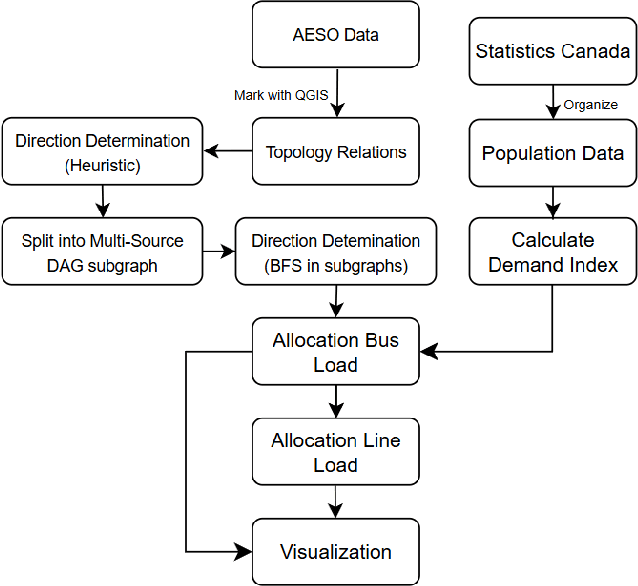

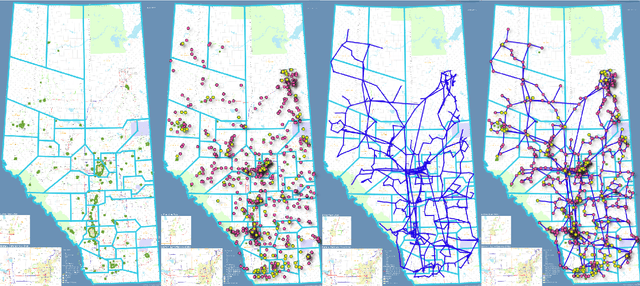

Abstract:In the power and energy industry, multiple entities in grid operational logs are frequently recorded and updated. Thanks to recent advances in IT facilities and smart metering services, a variety of datasets such as system load, generation mix, and grid connection are often publicly available. While these resources are valuable in evaluating power grid's operational conditions and system resilience, the lack of fine-grained, accurate locational information constrain the usage of current data, which further hinders the development of smart grid and renewables integration. For instance, electricity end users are not aware of nodal generation mix or carbon emissions, while the general public have limited understanding about the effect of demand response or renewables integration if only the whole system's demands and generations are available. In this work, we focus on recovering power grid topology and line flow directions from open public dataset. Taking the Alberta grid as a working example, we start from mapping multi-modal power system datasets to the grid topology integrated with geographical information. By designing a novel optimization-based scheme to recover line flow directions, we are able to analyze and visualize the interactions between generations and demand vectors in an efficient manner. Proposed research is fully open-sourced and highly generalizable, which can help model and visualize grid information, create synthetic dataset, and facilitate analytics and decision-making framework for clean energy transition.
From Specificity to Generality: Revisiting Generalizable Artifacts in Detecting Face Deepfakes
Apr 07, 2025Abstract:Detecting deepfakes has been an increasingly important topic, especially given the rapid development of AI generation techniques. In this paper, we ask: How can we build a universal detection framework that is effective for most facial deepfakes? One significant challenge is the wide variety of deepfake generators available, resulting in varying forgery artifacts (e.g., lighting inconsistency, color mismatch, etc). But should we ``teach" the detector to learn all these artifacts separately? It is impossible and impractical to elaborate on them all. So the core idea is to pinpoint the more common and general artifacts across different deepfakes. Accordingly, we categorize deepfake artifacts into two distinct yet complementary types: Face Inconsistency Artifacts (FIA) and Up-Sampling Artifacts (USA). FIA arise from the challenge of generating all intricate details, inevitably causing inconsistencies between the complex facial features and relatively uniform surrounding areas. USA, on the other hand, are the inevitable traces left by the generator's decoder during the up-sampling process. This categorization stems from the observation that all existing deepfakes typically exhibit one or both of these artifacts. To achieve this, we propose a new data-level pseudo-fake creation framework that constructs fake samples with only the FIA and USA, without introducing extra less-general artifacts. Specifically, we employ a super-resolution to simulate the USA, while design a Blender module that uses image-level self-blending on diverse facial regions to create the FIA. We surprisingly found that, with this intuitive design, a standard image classifier trained only with our pseudo-fake data can non-trivially generalize well to unseen deepfakes.
Spot the Fake: Large Multimodal Model-Based Synthetic Image Detection with Artifact Explanation
Mar 19, 2025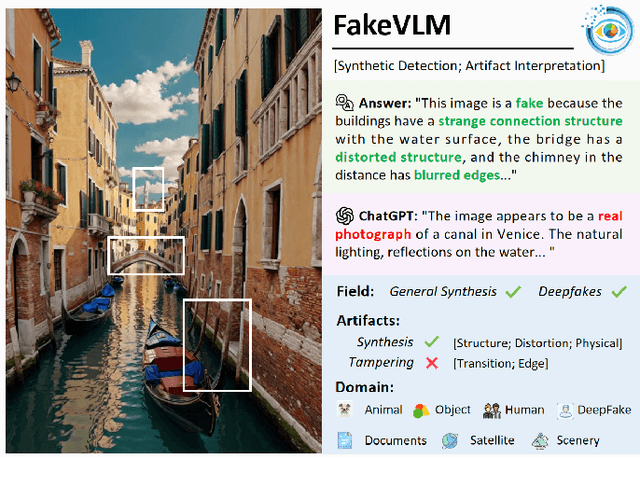
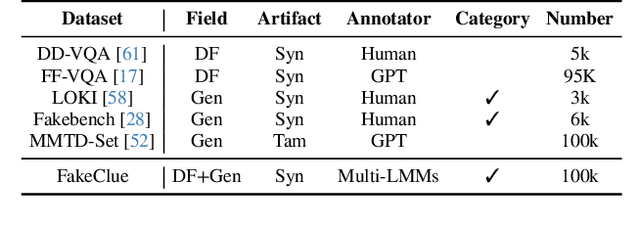


Abstract:With the rapid advancement of Artificial Intelligence Generated Content (AIGC) technologies, synthetic images have become increasingly prevalent in everyday life, posing new challenges for authenticity assessment and detection. Despite the effectiveness of existing methods in evaluating image authenticity and locating forgeries, these approaches often lack human interpretability and do not fully address the growing complexity of synthetic data. To tackle these challenges, we introduce FakeVLM, a specialized large multimodal model designed for both general synthetic image and DeepFake detection tasks. FakeVLM not only excels in distinguishing real from fake images but also provides clear, natural language explanations for image artifacts, enhancing interpretability. Additionally, we present FakeClue, a comprehensive dataset containing over 100,000 images across seven categories, annotated with fine-grained artifact clues in natural language. FakeVLM demonstrates performance comparable to expert models while eliminating the need for additional classifiers, making it a robust solution for synthetic data detection. Extensive evaluations across multiple datasets confirm the superiority of FakeVLM in both authenticity classification and artifact explanation tasks, setting a new benchmark for synthetic image detection. The dataset and code will be released in: https://github.com/opendatalab/FakeVLM.
Short-Term Load Forecasting for AI-Data Center
Mar 10, 2025



Abstract:Recent research shows large-scale AI-centric data centers could experience rapid fluctuations in power demand due to varying computation loads, such as sudden spikes from inference or interruption of training large language models (LLMs). As a consequence, such huge and fluctuating power demand pose significant challenges to both data center and power utility operation. Accurate short-term power forecasting allows data centers and utilities to dynamically allocate resources and power large computing clusters as required. However, due to the complex data center power usage patterns and the black-box nature of the underlying AI algorithms running in data centers, explicit modeling of AI-data center is quite challenging. Alternatively, to deal with this emerging load forecasting problem, we propose a data-driven workflow to model and predict the short-term electricity load in an AI-data center, and such workflow is compatible with learning-based algorithms such as LSTM, GRU, 1D-CNN. We validate our framework, which achieves decent accuracy on data center GPU short-term power consumption. This provides opportunity for improved power management and sustainable data center operations.
Hierarchical Learning-based Graph Partition for Large-scale Vehicle Routing Problems
Feb 12, 2025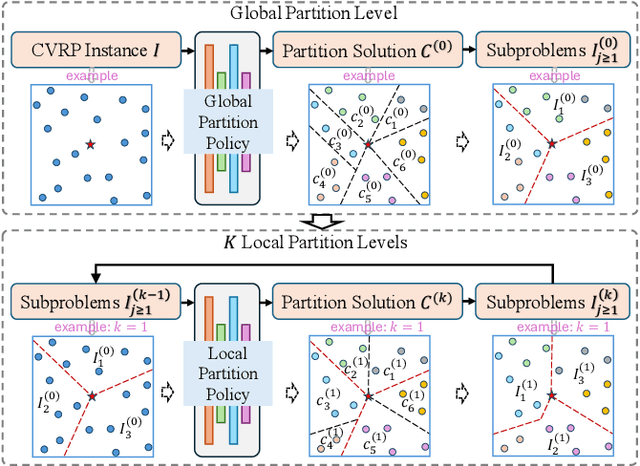
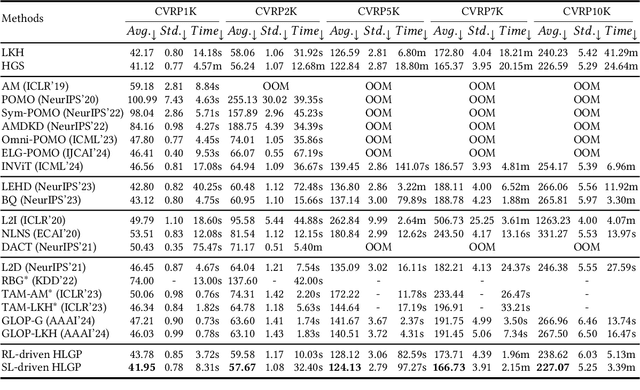


Abstract:Neural solvers based on the divide-and-conquer approach for Vehicle Routing Problems (VRPs) in general, and capacitated VRP (CVRP) in particular, integrates the global partition of an instance with local constructions for each subproblem to enhance generalization. However, during the global partition phase, misclusterings within subgraphs have a tendency to progressively compound throughout the multi-step decoding process of the learning-based partition policy. This suboptimal behavior in the global partition phase, in turn, may lead to a dramatic deterioration in the performance of the overall decomposition-based system, despite using optimal local constructions. To address these challenges, we propose a versatile Hierarchical Learning-based Graph Partition (HLGP) framework, which is tailored to benefit the partition of CVRP instances by synergistically integrating global and local partition policies. Specifically, the global partition policy is tasked with creating the coarse multi-way partition to generate the sequence of simpler two-way partition subtasks. These subtasks mark the initiation of the subsequent K local partition levels. At each local partition level, subtasks exclusive for this level are assigned to the local partition policy which benefits from the insensitive local topological features to incrementally alleviate the compounded errors. This framework is versatile in the sense that it optimizes the involved partition policies towards a unified objective harmoniously compatible with both reinforcement learning (RL) and supervised learning (SL). (*Due to the notification of arXiv "The Abstract field cannot be longer than 1,920 characters", the appeared Abstract is shortened. For the full Abstract, please download the Article.)
On the Compositional Generalization of Multimodal LLMs for Medical Imaging
Dec 28, 2024



Abstract:Multimodal large language models (MLLMs) hold significant potential in the medical field, but their capabilities are often limited by insufficient data in certain medical domains, highlighting the need for understanding what kinds of images can be used by MLLMs for generalization. Current research suggests that multi-task training outperforms single-task as different tasks can benefit each other, but they often overlook the internal relationships within these tasks, providing limited guidance on selecting datasets to enhance specific tasks. To analyze this phenomenon, we attempted to employ compositional generalization (CG)-the ability of models to understand novel combinations by recombining learned elements-as a guiding framework. Since medical images can be precisely defined by Modality, Anatomical area, and Task, naturally providing an environment for exploring CG. Therefore, we assembled 106 medical datasets to create Med-MAT for comprehensive experiments. The experiments confirmed that MLLMs can use CG to understand unseen medical images and identified CG as one of the main drivers of the generalization observed in multi-task training. Additionally, further studies demonstrated that CG effectively supports datasets with limited data and delivers consistent performance across different backbones, highlighting its versatility and broad applicability. Med-MAT is publicly available at https://github.com/FreedomIntelligence/Med-MAT.
Is Locational Marginal Price All You Need for Locational Marginal Emission?
Nov 18, 2024



Abstract:Growing concerns over climate change call for improved techniques for estimating and quantifying the greenhouse gas emissions associated with electricity generation and transmission. Among the emission metrics designated for power grids, locational marginal emission (LME) can provide system operators and electricity market participants with valuable information on the emissions associated with electricity usage at various locations in the power network. In this paper, by investigating the operating patterns and physical interpretations of marginal emissions and costs in the security-constrained economic dispatch (SCED) problem, we identify and draw the exact connection between locational marginal price (LMP) and LME. Such interpretation helps instantly derive LME given nodal demand vectors or LMP, and also reveals the interplay between network congestion and nodal emission pattern. Our proposed approach helps reduce the computation time of LME by an order of magnitude compared to analytical approaches, while it can also serve as a plug-and-play module accompanied by an off-the-shelf market clearing and LMP calculation process.
 Add to Chrome
Add to Chrome Add to Firefox
Add to Firefox Add to Edge
Add to Edge